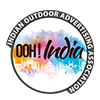
The way of life has shifted to digital and with each step we take, we must think beyond tomorrow now, and that’s what pDOOH does.
Precisely speaking, OOH is adopting technology to automate the mechanics of ad buying and selling process, which transform the manner in which ad campaigns are planned and traded on digital screens. It enables you for making the most of real-time opportunities.
In pDOOH you have a buyer and a seller, where the brand has the power to buy directly from the aggregators without human interference on one end. On the other end, it empowers brands and advertisers to reach the precise audience at the right time and place with relatable context, thus restricting ad spillage, and optimising their budget across marketing channels.
The technology for pDOOH opens the media to entirely new forms of advertising triggered by real-world events dynamically – both hyperlocal like weather and global ones such as cricket match scores and measurement capabilities towards an accountable ROI.
Could you share a few of your own initiatives/experiences in this regard?
Signpost India has commissioned India’s largest DOOH network spread across Mumbai, Delhi and Bengaluru including India’s biggest Digital Screen pair in Mumbai. Further, we have developed ‘Eflag’, a unique artificial intelligence platform for advertisers that is poised to revolutionise DOOH advertising by making every ad spend count through SEC classified vehicle count and recognition, slot-based impressions with OTS mirror and programmatic content selection and placement.
How promising is DOOH for the Indian OOH industry?
According to the FICCI-EY Media & Entertainment Report 2021, DOOH accounts for only about 4% of India’s OOH industry, as compared to an average of 20% in the more developed markets. However, the Indian OOH market will reach the global level of 20-25% DOOH spends in the next 5 years.
A smart innovation to emerge from the clutter was very much needed to devise the right OOH media plan, where the possibilities could be explored, but within the laws. That’s where DOOH is a game changer.
The OOH industry in India has already had to think of new ways to step out of the conventions when the entire world was bound to be “in-their-homes”. This resulted in a transition that changed the traditional OOH ad-buying process to include DOOH. As overall OOH share continues to migrate to DOOH formats, the need for DOOH has moved from novelty to sustainable leveraging the uniqueness of OOH – Impact, Action-Oriented, Relevance and Creative freedom, that cannot be emulated on a scale on social/online media formats.
Is the Indian OOH industry prepared for programmatic?
Over the years, many OOH media owners have emerged in India offering various sizes and locations of media spaces but within the bounds of certain laws of the country. With p-OOH coming into the picture, media owners can now further maximise the usage of their inventory and expand on the offerings that were earlier limited.
However, DOOH itself is in the nascent stage in India as compared to developed markets. Hence programmatic and automation will take time for adoption.
The integration of DOOH in omnichannel media plans will define the foundation of each ad campaign for any brand or advertiser going forward, but migration from the conventional OOH to p-DOOH is not going to be an easy road.
So yes, we are still in the learning phase of the ideology and working behind programmatic OOH, however we are confident it will grow stronger at a faster pace.
What do you think are the specific challenges that need to be addressed?
Lack of syndicated data has always been challenging for the OOH industry and brand marketers are constantly looking for data that foster authenticity.
The industry needs to invest in technology to provide authenticated data for the brands to enable them in measuring effectiveness and ROI of their campaign.
An important aspect is the science behind choosing the right location through the right kind of measurement metrics along with relevant content while understanding the format and dynamism.
Another key challenge is to get the regulators to have a reasonable approach on transformation from static to dynamic canvas, as DOOH adds to the aesthetics of the city. Leveraging the one nation one tax approach will generate better revenue from each sale in lieu of constant hard pay-outs. There should be a reasonable shift from licenses to tender-based approach, seeking partnerships with an open mind and distancing from litigation and hardship for all the stake holders.
So, what do you think is the immediate next step for programmatic to become more accepted in the industry?
While jumping onto the “Programmatic Playout” wagon, understanding the possibilities one can unlock as a brand will be the biggest next step.
Since it slashes the conventional tools of measurement through its automated system of identifying the reach, measuring engagement potential, reconsidering options of placement, and enhancing creative orientation – brands will soon come to see through all this.
Understanding the offering of how it can be adopted to run a campaign efficiently will validate its acceptance in our country.


_525_860.jpg)